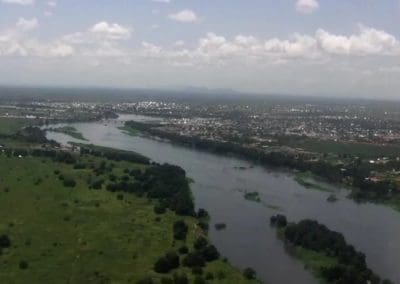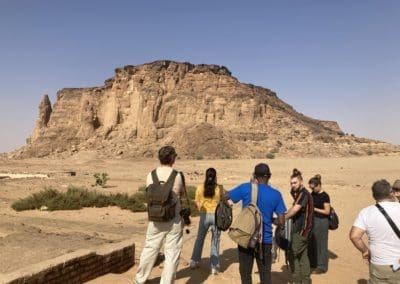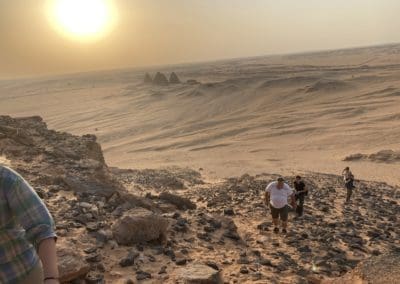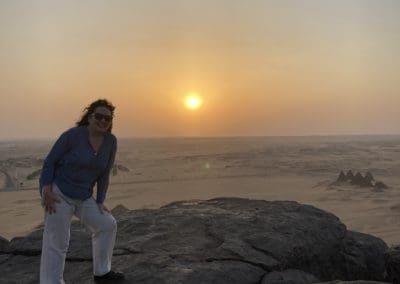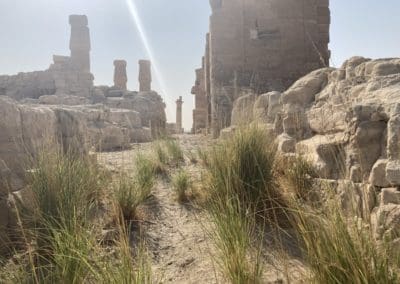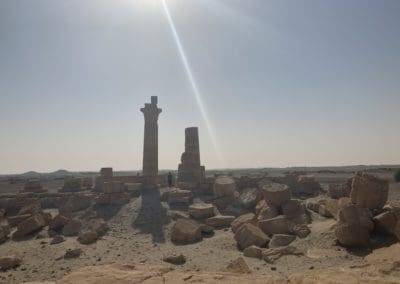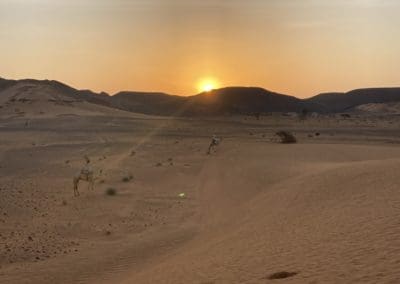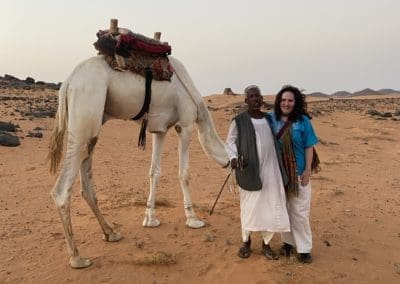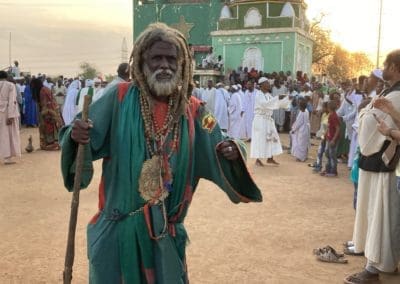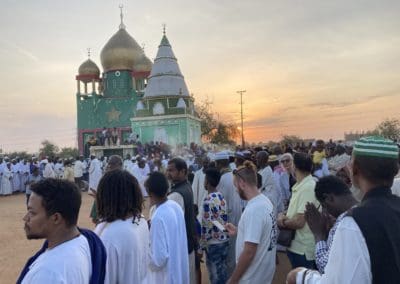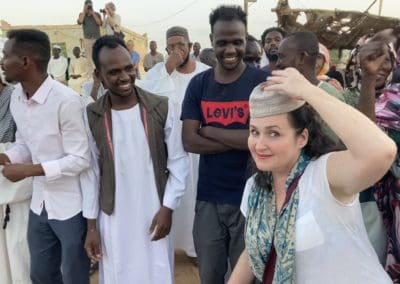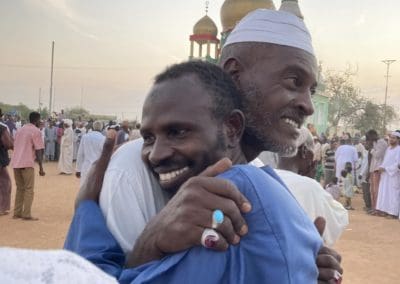A pastiche of stories from our journey through Sudan, October 2021
by Laura Ranieri Roy
We were honoured to be part of a small group of travel experts and journalists to travel through the unfathomed land of North Sudan in October 2021 – and met with wonders each step of the way. Here is a collection of special moments, images and ideas sparked through this unique odyssey.
It’s morning in Khartoum – the first day of our journey. This is the place where the blue and white Niles meet, merging into the great river that shaped Egyptian and Nubian civilization. Birds swoop over the flood plain near Tuti island. The Corinthian hotel – like an intergalactic spaceship –is perched over the Blue Nile. Khartoum was established in the 19th century. It is a market town built on the ivory trade and slavery. Elephants once roamed this land. Now they are only found in far south Sudan The famous death of General Gordon, felled on the steps of the parliament by the blades of the Maadi happened here.
The Road to Old Dongola
As our Toyota all terrains spin along the smooth new asphalt road… a world untouched by time spins past – donkey drivers riding atop tin water barrels – like oil cans. A local market for mudbricks, with donkey carts loaded with rich red Sudanese soil – so many walls and buildings only half finished… incipient structures that look like ancient walls of temples. Little has changed in how people here build their homes. We pass a local goat market – a mass of brown creatures, men with sticks swatting them along between dusty jeeps. Along the sides of the asphalt, piles of garbage strewn, some already incinerated. They burn their garbage here. Past a checkpoint and we wave Khartoum goodbye… Acacia Tortulis bushes – squat and thorny rise up out of sunbaked brown soil. These trees bear sharp branches – weapons needed to survive the unforgiving climate The vast western desert mixed with patches of pale green grass – like beard stubble. This is the Sahel ecosystem – It is actually semi desert – with only 150 millimetres of rainfall each year.
The temperature in late October still soars above 40 degrees midday. Turn off the road and you meet undulating sand dunes. Camels wander the sands – like white ghosts of the desert some in herds driven by shepherds – some loping along stampeding towards the asphalt as if to stage an attack on motorists. Carcasses of donkeys, goats appear along the road. Recent deaths. Here is the blazing heat, an animal is reduced to hide in less than two years. Humans too… if they perish in this wasteland, the bodies will desiccate in just over a year.
Umm el Hassam rest stop.
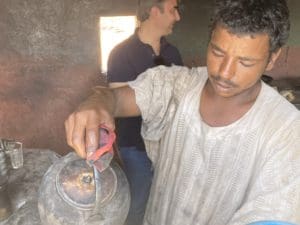
An old man reclines on a bed in the desert heat, under a simple tin roof. The road from Khartoum through to the border with Egypt is not paved with gold. But it is with asphalt.A surprisingly smooth new road cuts a straight path through the heart of this hot, unspoiled and untouristed country. Wayfarers like our small band of travelers need shade and rest along the way. Some 20 years ago, an enterprising Sudanese woman started a break stop offering weary travelers fresh cooked coffee and some shade from the heat of the day. The coffee stop became famous across Sudan – with journeymen coming for the delicious coffee and warm hospitality of Umm el Hassam (the mother of Hassam). In fact, Umm even received an award of excellence from the president of Sudan. A few years ago, Umm el Hassam passed away but today her sons continue to run her popular coffee stop and ensure her legacy here… on the road to Old Dongola.
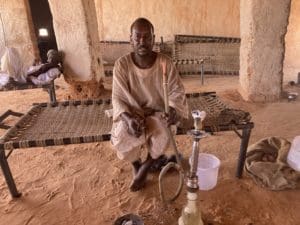
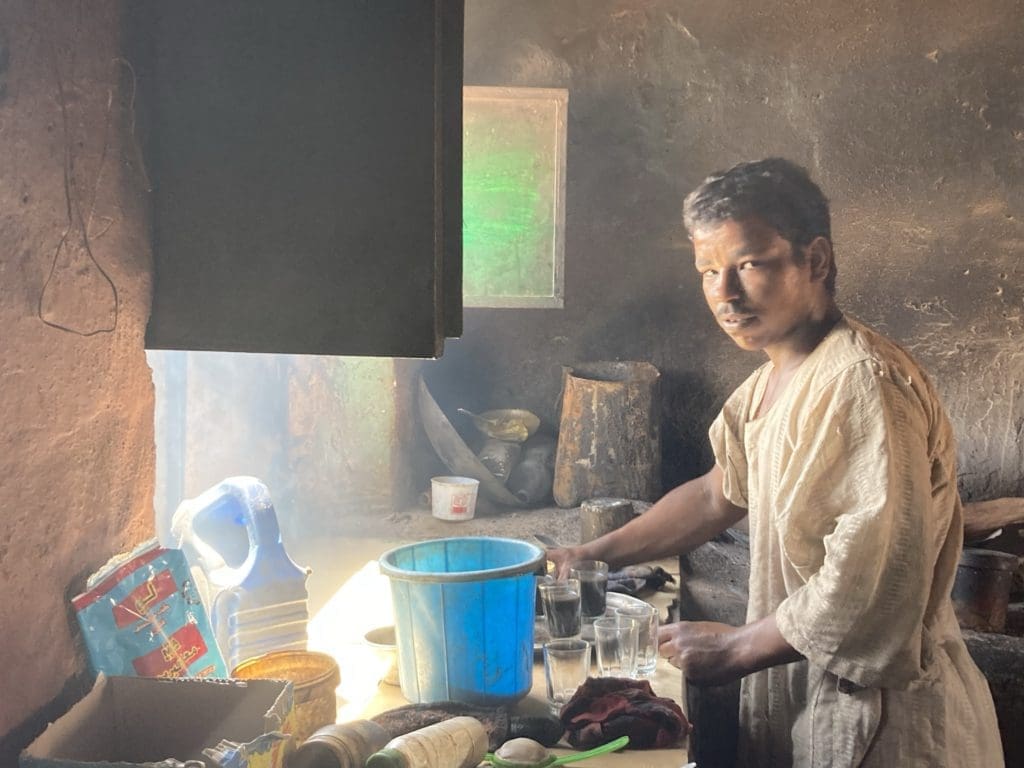


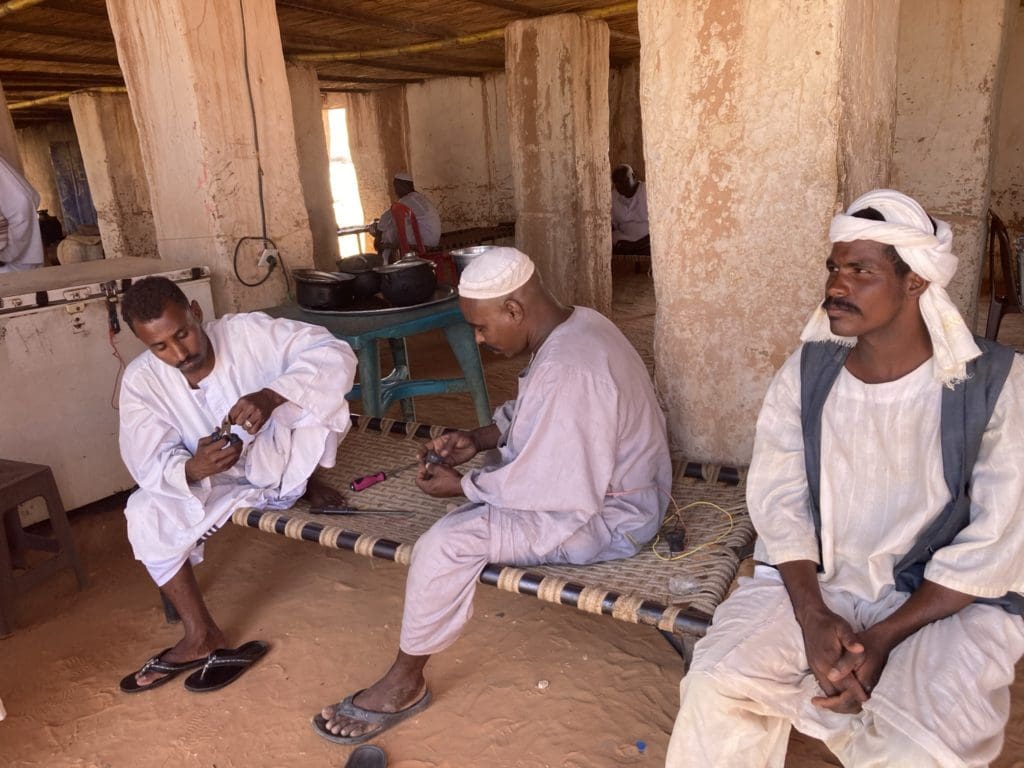

Climbing Gebel Barkal: Birthplace of Amun
The Great Temple of Soleb
Like the swiss explorer Burkhardt more than 200 years ago, we traversed the trackless, untrodden Sudanese countryside just south of the third cataract. We come to a mudbrick factory and the tranquil shores of the Nile, wide and high. Hopping aboard a fishing boat we cross this stunning stretch of river to the West.
Almost 3500 years ago, the great Amenhotep III and his architect Amenhotep son of Hapu also crossed here. They came to establish Egypt’s southern border and celebrate the king’s hebsed with the erection of a great temple. This magnificent edifice rises out of the bucolic palm groves and wilderness with its fine pillared forecourt and ruined hypostyle. Here is the domain of Amun and a deified Amenhotep III – with reliefs of his Nubian captives. Akhenaten was here, and Tutankhamun, Ay and Horemheb too. Now we walk in their footsteps.
Camel Milk and Watering Holes
Light and sweet. That’s how my fellow traveler said the fresh frothy camel milk tasted. A desert nomad offered me a sip, and I so regret now declining. We met four nomadic families with their herds of goats, sheep, donkeys and camels living in a lean-to near a well and two watering holes. This was their desert home for now. They practice subsistence living, surviving off the meat and milk of their herds.
Deep holes, dug 50 metres or more into the red earth yields water, the staff of life. They draw it out with simple levies, goatskin containers, acacia branches, rope and the strength of their donkeys. We meet the very young… and very old, a lady named Medina, the matriarch of this tribe in her 90s. The teenage son, I heard, now has a metal detector and may leave the tradition of his family for the allure of gold prospecting. Most touching of all is how these simple, pure people reach out to us, not for money, but only to connect with rough sandpaper handshakes and welcome us to their land, Sudan.


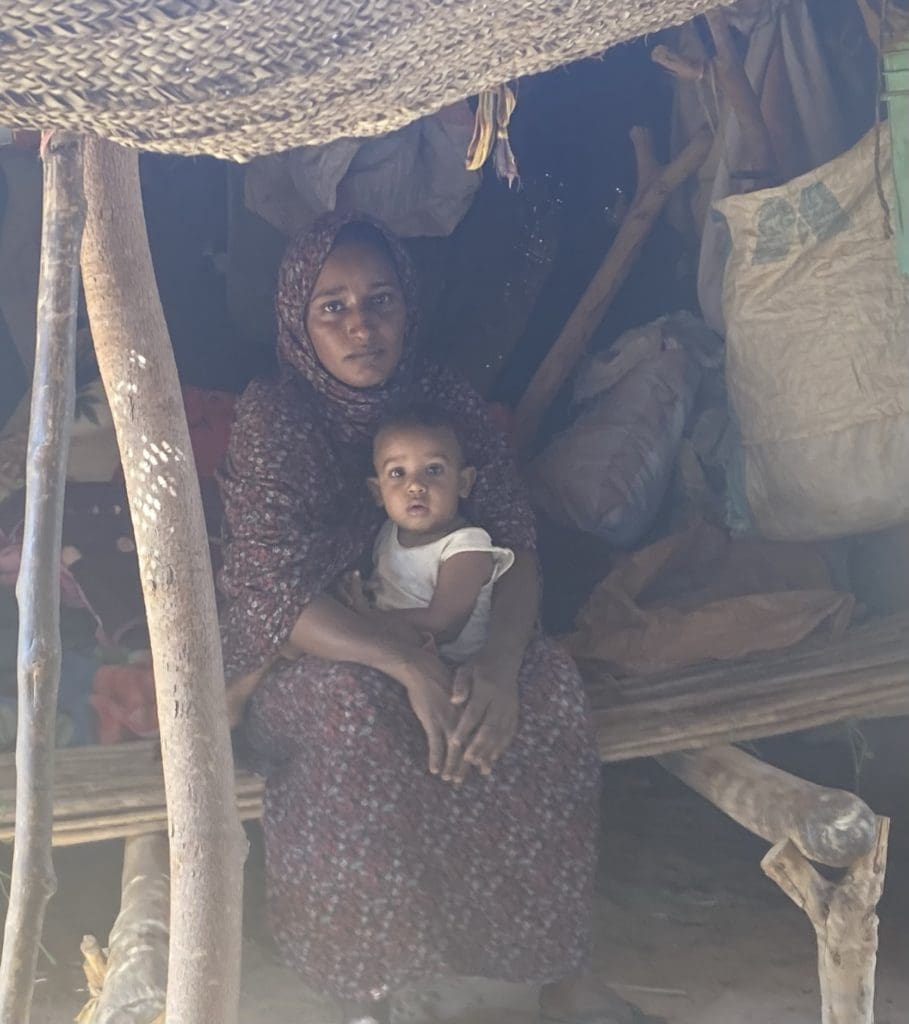
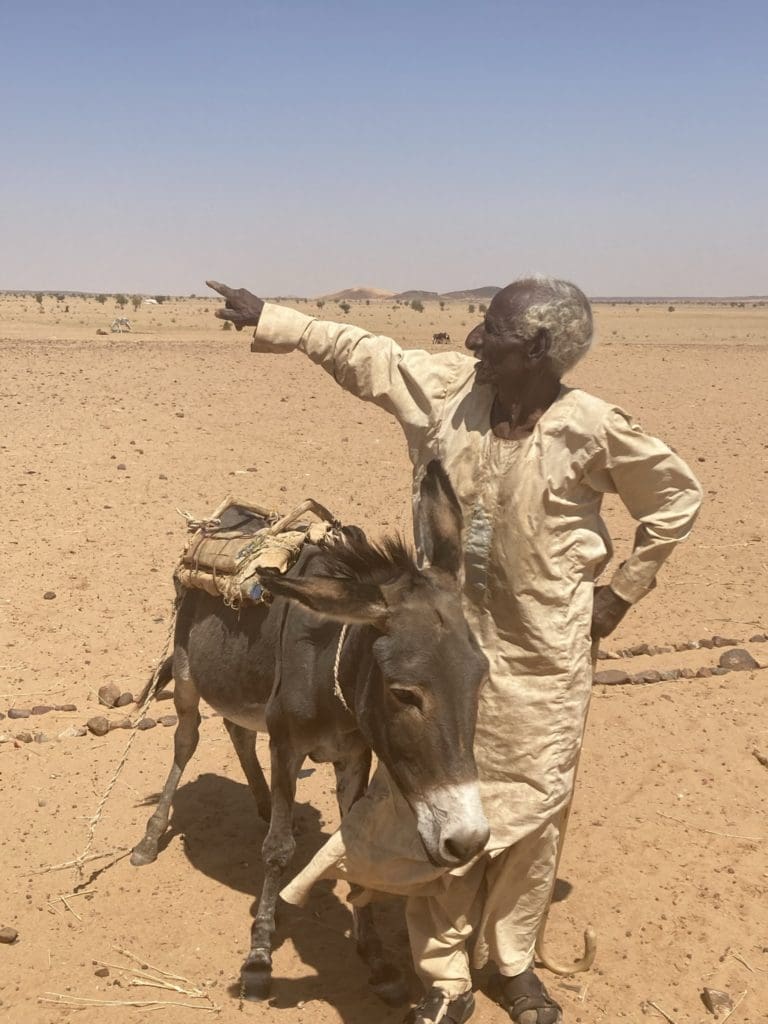





Searching Sunset at Meroe – a personal treatise
More than 2000 years ago, powerful Nubian kings and queens chose the cleft of a hillside in the red Nubian desert to erect their monuments for eternity: pyramid tombs small but steep. Instead of building in the monumental size of the Egyptians, the Nubian pyramids chose a high location to ensure their journey across the sky to be reborn with the sun.
We arrived as that same sun on October 21, 2021, was turning deep gold in the western sky, the dying Atum, the sun at the end of the day. Some kings were buried in the north and others across a cleft in the desert valley in the farther higher desert hills to the south.
Where would be the best view of that sunset? Where would the rays be most magnificent? That was the dilemma I faced… with less than an hour before the great fiery ball would be swallowed by the western horizon.
With long strides in the untrodden, thick sand I traipsed across the desert wadi, white Nubian camels approaching from the east, hoping I would pay for a ride. Once across I surveyed the strange little tombs. Sharp, many broken with only their decorated front funerary temples remaining.
Where the sun would set most beautifully was a question these ancients too must have asked. For the first queens and kings, it would have determined the site of their pyramids. Higher was better, as clear from the oldest pyramids occupying the choice clefts. But with this array of spiky ruins, like jumbled red chess pieces on a board, what spot would afford the very best views right now? I saw some others who had climbed to a hill in the south, I hurried across the deep sun banks in a race with the setting sun. I arrived and watched the now deep red ball hang over the horizon between the silhouettes of pyramids. But was this really the best vantage point? I took a few thoughts but, worried some better view might be missed – I scurried off again – down the hill… peering, searching the horizon. Maybe where I was had been best? Maybe I should not have left the northern pyramids? As the sun continued to melt into pinks and golds, I walked and peered, snapping shots as I could – but… perhaps I should not have moved? Then it was gone and only a golden glow illuminated the pyramid fields.
I decided to say yes to an old man who offered me a ride back on his strong white camel, Abu. It was beautiful. I am not in my sunset years certainly, and yet the sun for me is beyond its full midday light… slowly edging towards the western horizon for my life… Like the kings of old, choices must now be made that are vital. There is only one vantage point from which you can truly savour the beauty of the falling light. Failure to select your path wisely may compromise that beautiful view. And a fear of missing something better… may leave one stumbling in the shadows searching, missing that most breathtaking beauty before the light goes out.
 TTh
TTh
Surviving the Military Coup – and the Real Gold of Nubia: The Sudanese People!
We had just danced at sunset with the warm, welcoming Sudanese people, immersing ourselves in a Sufi ritual at the Khartoum Friday festival. It took place in a cemetery at dusk – and yet was respendant with such joy. Two days later we wake up to a military coup – and a state of emergency in Khartoum, and across Sudan. Internet is cut off, bridges, roads and the airport all closed. The president taken to an unknown location. Fortunately for us we are safe at. the Acropole hotel- that lighthouse of information and safety in the heart of Khartoum. Headline stories around the world about the state of emergency in Sudan – and the France 24 journalist – Bastien Renouil – was staying just a couple of rooms from us.
Many of the warm and genuine young men with whom we sang, swayed and shared incense at the festival may now be out demonstrating on the streets. Crowds of protesters, increasingly violent, are pouring out across the city. 14 people have been injured so far. They want a better government that will protect them, care for their families and all the people of Sudan… and create a better life for all.
Certainly, we saw unthinkable poverty as we traversed the country. We witnessed the barest level of housing conditions, mere subsistence living – and yet never felt harassed or unsafe.
I think of the young man with a face as dark as ebony and blindingly white smile, who welcomed me, told me of his proud heritage – and lineage that went back to the Meroitic kings. He introduced his friends, brothers, and a poor disabled soul enjoying the celebration. He told me I was kind… But to me, it is the Sudanese who are kind. Perhaps the kindest of any people I have ever encountered.




